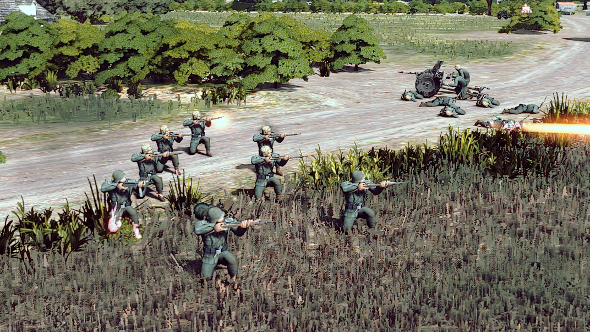
The intimidating Panzer rumbles down the pockmarked French nation street within the extra bucolic of the 2 maps obtainable in Steel Division: Normandy 44’s beta. It’s prowling for targets, particularly my courageous troops, all members of the 15th Scottish Infantry Division. I don’t have any tanks of my very own, however huddled behind the bushes on both aspect of the street are a handful of my troopers. Waiting.
Related: the best strategy games on PC.
They strike because the tank passes, tracers chopping via the air, bullets pinging off its extremely thick shell. The Panzer is unhurt, shrugging off even this relentless assault, however not so the boys caught inside it, crammed in like sweaty sardines. The noise and the chaos is an excessive amount of for them. They panic, and this lethal warmachine falls again. It’s a short victory for the underdogs, and it’s all due to Steel Division’s stress mechanic.
Eugen System’s World War 2 Wargame spin-off cares an important deal about logistics and provide, armour and weapons – all of the transferring components and substances of battle. But amid all of the numbers and stats, the armour rankings and bullet counts, it doesn’t overlook that there are flesh and blood troopers, typically daring and courageous, typically terrified and careworn, preventing on this conflict. Their psychological state issues simply as a lot because the instruments that they use.

Stress is the expression of Steel Division’s suppression system. When a unit begins to take hearth, its stress meter will increase. The bullets don’t even have to hit their mark – so long as they’re shut, items react to the hazard. How a lot the stress meter will increase is decided by the proximity of the hazard. If a unit truly will get hit, the meter jumps up and the troopers enter a careworn state.
Different unit sorts react in distinct methods after they turn into careworn. Vehicles, just like the aforementioned Panzer, have two completely different states. A car turns into shaken when the meter reaches 50%, inflicting it to start out transferring backwards. You can nonetheless management the car, giving it orders, however there’s a threat concerned: it might turn into panicked. If that occurs, when the meter is full, all management is misplaced and it retreats. Things are a bit easier with air items, which depart the map as soon as the meter is full.

Since fleshy infantry are significantly extra susceptible, they’ll hit the bottom as a substitute of mechanically falling again, which additionally signifies that they’ll cease firing, successfully turning into ineffective. Unless they cease being below hearth, they gained’t settle for any orders aside from the retreat order, which is able to ship them operating for the closest cowl. If they’re in enemy territory, surrounded, and with no chief unit close by, the unit could even give up and be taken out of the battle completely.
Shock and awe, then, is a very necessary tactic. Not surprisingly, artillery show to be particularly useful when making an attempt to scare the hell out of enemies. Though not particularly correct, they’ll bombard enemy positions with suppressive hearth, giving entrance line items a chance to cost at terrified foes, forcing them to capitulate. It’s an intimidating show. Steel Division is a placing, detailed sport, and you may get proper up near the motion, watching susceptible troopers drop like a sack of potatoes because the little French farm they’re cowering in is turned to rubble, and explosions and smoke fill the world.

When falling sufferer to it, the stress mechanic takes management away from you, which below some circumstances is perhaps a bit irritating, reminding you that you simply’re extra of a common than a god of the battlefield, however you’re not left with out choices. It highlights obstacles that have to be overcome and offers you time to counter the supply, the assault, doubtlessly earlier than the unit is misplaced.
Importantly, it additionally makes it really feel like a comeback is feasible. Fleeing items may be despatched again into the fray, and subsequent time you’ll have further intelligence that would maintain them within the battle for longer. And It creates a way more pure circulation to battles, with items transferring and appearing logically, the place victory or failure isn’t merely a matter of destroying enemy items or watching your personal being destroyed.

As the attacker, you possibly can win battles via guile, even when going through closely armoured enemies. You may face that unit once more, however in conquest mode specifically, the place victory is claimed by taking probably the most territory, forcing an enemy to retreat may be much more efficient than destroying them outright. While extra realistically simulating the extreme strain of warfare, the stress mechanic concurrently creates conditions that evoke extra romanticised tales of valour and dedication – heroes who ship superior forces packing via a relentless and shock assault.
Even inside teams, like infantry, it’s not a one-size-fits-all mechanic. When designing your division, it’s price taking the composition of your power into consideration with reference to emphasize. Untrained (or unwilling) troops usually tend to turn into too careworn, extra superior items can deal with extra and squad leaders can encourage a bit extra bravery amongst close by troopers. That doesn’t imply you need to keep away from items with much less psychological fortitude, nevertheless. They value much less, permitting you to doubtlessly subject extra items, overwhelming the enemy via superior numbers.
Stress and suppression are, up to now, probably the most intriguing components of Steel Division: Normandy 44, feeling each thematically applicable for the World War 2 setting whereas additionally making it stand out from its progenitors like Wargame: AirLand Battle. Though it shares similarities with the morale methods present in some turn-based wargames and the Total War collection, it’s extra an evolution than a replication, encouraging gamers to have interaction with it or put together for it fairly than simply being a menace.
Source


